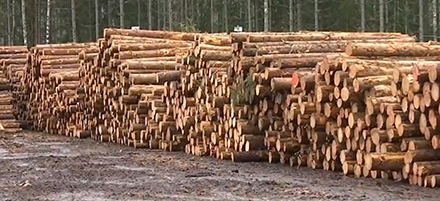
Timber prices in Estonia have started rapidly falling from their spring-time high. The situation is described by industry insiders as serious and likely to impact the entire forestry sector. A cooling of the global economy and widespread damaged to fir trees in central Europe are the likely culprits. Source: Timberbiz
Martin Arula, CEO of Toftan, one of the largest sawmills in the Baltic States and based in Võru County, said the current situation on the timber market was comparable with a crash in prices that happened 2007-2008.
“The global economic downturn is still very clear,” Arula said.
“We have seen price falls of up to 60 percent in the various international export markets, compared with nine months ago. Within the Estonian market, wood product prices have fallen a bit less than this – we’re talking about 20-25 percent – but this shouldn’t be taken as an indicator that we are somehow isolated from the rest of the world, leaving us to remain on some sort of higher level.”
Price falls in Estonian pulp wood and firewood have been higher, at up to 40%, even though sawmills are calling it a normalization of the market, ERR – the English-language service of Estonian Public Broadcasting – reports.
“These [higher] prices, which were the case almost a year ago, were somewhat ‘utopian’, and were partly the result of the wet autumn of 2017,” said Jürgen Ainsalu, CEO of timber products firm AS Barrus.
“Since then, pulpwood producers in Scandinavia started to decline while market demand remained high, which led to a price rally in the Baltics,” he said.
Issues with firefighting techniques have severely damaged evergreen tree stocks in particular, in Central Europe, an effect which has been felt in Estonia too, and have had a strong impact on buying prices.
“Damaged spruce timber has been available [on European markets] for less than €30 per cubic meter, whereas we can’t afford to go lower than €60 per cubic meter,” Arula said.
“The current glut, combined with the cool economic downturn, is still really serious,” he added.
The knock-on effect to the sector as a whole will be significant, larger sawmills say, though there has been no talk of lay-offs or downsizing yet, ERR reports.
Forestry spokespersons note that private forest owners need to plan seriously their forest management right now, however.
“If a forest owner has nowhere to sell their timber, or it is no longer profitable, many forests will still be left without being managed,” said Erki Sok, CEO of the Võru County forestry association.
“This will affect everyone, be they timber fellers or exporters,” he said.
Estonian forest cover amounts to around two million hectares, about 50% of the country’s land area. Of this forest cover, about half is state-owned and managed.





